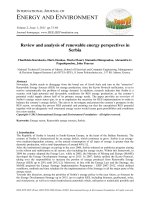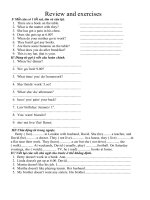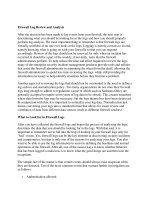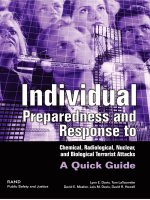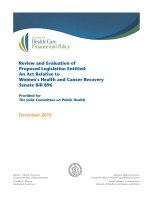Ps review and response report oct 2016 march 2017
Bạn đang xem bản rút gọn của tài liệu. Xem và tải ngay bản đầy đủ của tài liệu tại đây (710.8 KB, 38 trang )
Patient safety review and
response report
October 2016 to March 2017
A summary of how we reviewed and
responded to the patient safety issues you
reported
17 January 2018
We support providers to give patients
safe, high quality, compassionate care
within local health systems that are
financially sustainable.
Contents
Why publish this report? ................................................................... 2
How we review and respond............................................................. 3
Information review ................................................................................................... 3
Should we issue a Warning Alert? .......................................................................... 6
Should we issue a Resource Alert? ........................................................................ 8
Should we issue a Directive Alert?.......................................................................... 9
Who advises us?................................................................................................... 11
What action did we take? ................................................................ 13
Patient Safety Alerts ............................................................................................. 13
Issues where we advised or influenced others on action ...................................... 16
Partnership learning from specialist review of NRLS data .................................... 27
Journal articles including review of NRLS data ..................................................... 27
Acting through our MSO and MDSO networks...................................................... 28
The MDSO network ........................................................................................... 28
The MSO network .............................................................................................. 29
Inspired to report? ........................................................................... 32
Interested in finding out more about our wider work? ........................................... 32
Acknowledgements ......................................................................... 33
Appendix 1: Journal publications including review of NRLS data .. 34
1 | > Contents
Why publish this report?
Reporting all patient safety incidents, whether they result in harm or not, is
fundamental to improving patient safety. The national action we take as a result of
what we learn from incident reports is vital in protecting patients across the NHS
from harm.
Year-on-year reporting to the National Reporting and Learning System (NRLS)
continues to grow and we now receive over two million incident reports each year.
This report is the second of its kind: it explains how we reviewed reports in the
period October 2016 to March 2017 and describes the action we took as a direct
result, whether by issuing a Patient Safety Alert or working with partners. You can
find the report covering April to September 2016 on our website.
First and foremost this publication is a thank you to all the staff, patients and
members of the public who have taken the time to report incidents. By showing the
difference your efforts have made, we hope you find this report both informative and
inspirational, and that it encourages you and your colleagues to continue to report
all incidents so that together we can improve patient safety and protect our patients
from harm.
2 | > Patient safety review and response report, October 2016 to March 2017
How we review and
respond
Most patient safety challenges, such as reducing diagnostic error, preventing selfharm, avoiding falls or managing long-term anticoagulation, are well recognised.
These ‘giants’ of patient safety have complex causes and no simple solutions. They
are the focus of wide, long-term programmes, including initiatives led by NHS
Improvement and other organisations, and through partnerships. Such initiatives
include the Patient Safety Collaboratives, the Maternal and Neonatal Health Safety
Collaborative and the Patient Falls Improvement Collaborative. The information we
routinely collect through the NRLS and other sources informs this work.
But a national system can also identify new or under-recognised patient safety
issues that may not be obvious at local level. When we identify these issues, we
work with frontline staff, patients, professional bodies and partner organisations to
decide if we need to issue advice and guidance to reduce risks in a Warning Alert,
or if we can influence or support others to take action. You can watch a short video
on how we do this.
A national system can also develop or promote new resources that help the NHS
improve a known safety issue. We do that by issuing a Resource Alert. When a
specific technical change or safer procedure has been developed and tested, we
may also issue a Directive Alert.
Information review
Our role starts with the clinicians in our patient safety team reviewing information
from a range of sources to identify new or emerging issues that may need national
action. We call this our ‘review and response’ function.
This function is supported by registered nurses with experience in patient safety
and surgical, medical, community, paediatric, neonatal and mental healthcare, a
midwife, pharmacists, a pharmacy technician and a physiotherapist, many of whom
work on wider patient safety policy and projects as well as review and response.
Additionally, we use the skills and experience of expert patient safety advisors who
3 | > Patient safety review and response report, October 2016 to March 2017
combine working one day a week with us with clinical, educational or leadership
roles as GPs, paramedics or in the care home, mental health or learning disability
sectors. Administrative support for our response function helps us track and record
the multiple issues we need to act on. We also access internal human factors and
behavioural insights expertise to inform our work, and support team members to
develop their expertise through postgraduate courses.
Where any of these sources suggest there could be a new or under-recognised
issue that requires national action we explore further. Although our process is often
triggered by a single patient safety incident, from that point onwards we work to
understand the patient safety issue. We do this by looking to identify any wider
pattern in other similar incidents reported previously, including no harm ‘near miss’
incidents – and we focus on what could go wrong in future.
4 | > Patient safety review and response report, October 2016 to March 2017
Figure 1 below gives the sources of the 70 issues our clinical teams identified
between October 2016 and March 2017 and took forward for potential national
action.
Figure 1: Sources of issues we took forward for potential national action
5 | > Patient safety review and response report, October 2016 to March 2017
Should we issue a Warning Alert?
Our process starts with looking for new and under-recognised
risks, but not all of these will require a Warning Alert. To
identify if a Warning Alert or other action is needed, we:
1. Talk to experts, patients and their families, and frontline staff to confirm the
risk is new or under-recognised; these groups may have different
perspectives.
2. Check whose remit an issue falls under, as some aspects of patient safety
are handled by other national organisations and we can pass these to them
for action. Other patient safety issues can be addressed at source, for
example by the manufacturer of a device.
3. Look for up-to-date detail about the issue in the NRLS, research studies and
other published material, and seek advice from specialists and frontline staff
to help identify the likelihood of this happening again and the potential
for harm.
4. Explore whether organisations can do something more constructive than
simply raising awareness and warning people to be vigilant against error,
and the options for these actions (including interim actions while more robust
barriers to error are developed).
5. Consider our audience; if an issue is only relevant to a specialist group or
specialist service, it can be more effective to communicate with them directly
rather than to issue an alert.
These five questions are also illustrated in Figure 2:
6 | > Patient safety review and response report, October 2016 to March 2017
Figure 2: Identifying and responding to new or under-recognised risks
If an answer falls into any grey box, the risk is not a new or under-recognised issue
that we can act on.
If answers for a risk fall into amber boxes only, we look to share our findings with
partners working in the relevant specialty, such as a royal college, and support
them to develop ways to further prevent the risk; examples of where we have done
this are given later in this report (see section ‘Issues where we advised or
influenced others on action).
If answers fall into both red boxes and no grey boxes, a Warning Alert will be
planned and issued.
7 | > Patient safety review and response report, October 2016 to March 2017
Should we issue a Resource Alert?
These are typically issued in response to a patient safety issue
that is already well-known either because an earlier Warning
Alert has been issued or because awareness has been raised
through other publications or national initiatives. Resource
alerts are used to make healthcare providers aware of any substantial new
resources that will help to improve patient safety; they ask healthcare providers to
plan implementation in a way that ensures sustainable improvement. We ask the
following questions before planning or issuing a Resource Alert:
Are the resources…
Addressing an issue
that causes, or has
potential to cause,
severe harm or death?
Why is this important?
This helps healthcare providers
implement resources where they are
most needed. Resources addressing less
serious issues can be shared through
less formal routes.
New, or include some Resource Alerts have their greatest
new or underimpact if they are part of an overall plan
recognised content?
to support uptake and implementation of
new resources.
Published by one or
more national 1 bodies,
professional or patient
organisations or
networks, bearing their
logo and hosted on
their website?
This ensures the resources are
developed with the necessary specialist
expertise to give them credibility, and
ensures they will be updated or removed
when evidence or best practice changes.
Local resources can be shared through
less formal routes.
Substantial, in relation
to the patient safety
issue?
This question relates to whether the
resource or resource set addresses a
substantial part of the patient safety
issue. Resources that only address a
narrow aspect can be shared through
less formal routes.
1
By national, we mean an English or UK-wide organisation. International resources can be
promoted through other routes as national differences in service provision and regulation usually
mean adaptation rather than direct adoption is often needed, although we may sometimes highlight
international resources that are clearly relevant and ready to use in England.
8 | > Patient safety review and response report, October 2016 to March 2017
Practical and helpful?
Publications that serve only to deepen
our understanding of a problem have
value, but in isolation they are not
resources and can be disseminated
through other routes.
Focused on patient
safety improvement?
Public health messages and other
aspects of quality (such as clinical
effectiveness guidelines from the
National Institute for Health and Care
Excellence (NICE), and materials to
improve patient experience) have their
own communication routes.
Relevant to most
healthcare providers in
at least one healthcare
sector?
If the resources apply only to a specialist
service provided by the minority of
providers in a sector, their
communication can be directly targeted
instead.
Should we issue a Directive Alert?
These are typically issued because a specific, defined action
to reduce harm has been developed and tested to the point
where it can be universally adopted, or when an improvement
to patient safety relies on standardisation (all healthcare
providers changing practice or equipment to be consistent
with each other) by a set date. All types of alert carry equal weight; Directive Alerts
differ from Warning and Resource Alerts only in terms of how specific and defined
the actions are. We ask the following questions before issuing a Directive Alert:
Are the actions required…
Why is this important?
Addressing an issue that
To help healthcare providers focus
causes, or has potential to their efforts where they are most
cause, severe harm or
needed.
death?
9 | > Patient safety review and response report, October 2016 to March 2017
Developed and tested to
the point we can be
confident the actions are
the sole or best current
approach to improving
safety, are practical and do
not introduce new risks?
In complex healthcare systems, even
with the best possible proactive risk
assessment, a change that is
expected to make an improvement
can have unintended effects. Unless
the required actions have already
been successfully implemented by a
number of healthcare providers, it is
usually appropriate initially to allow
more flexibility for local adaptation
through a Warning or Resource Alert.
Provides an effective
barrier to error or requires
standardisation to a single
consistent approach
across the NHS?
Where no strong or moderately strong
barrier has been identified a Warning
or Resource Alert is usually more
appropriate. Directive Alerts are
appropriate where they provide an
effective barrier to error or
standardisation is required to ensure
a single consistent approach across
the NHS (eg requiring a standard
crash call number).
Is the cost (especially new
and direct costs such as
equipment purchase)
proportionate to the
reduction in harm the
actions can be expected to
achieve?
Calculating the scale and cost of
current harm and the impact of the
intervention is not straightforward for
most patient safety issues, but we
work within the principles of cost per
year of quality-adjusted life used by
NICE, so that finite NHS resources
are directed at the patient safety
issues where they have the greatest
impact. For some issues, potential to
reduce costs of litigation may also
need to be factored in.
Acceptable without wider
public consultation?
For actions where our National
Patient Safety Response Advisory
Panel is concerned about adverse
impacts or costs, or has conflicting
views on which of two or more current
approaches to adopt as standard, a
wider public consultation may be
needed.
10 | > Patient safety review and response report, October 2016 to March 2017
Relevant to most
healthcare providers in at
least one healthcare
sector?
If the actions apply only to a specialist
service provided by the minority of
providers in a sector, their
communication can be directly
targeted instead.
Who advises us?
Insight to help us understand each patient safety issue mainly comes from frontline
staff, patients, professional bodies and partner organisations on our National
Patient Safety Response Advisory Panel. This panel is made up of:
Our panel is made up of representatives encompassing a range of roles within NHS
acute, mental health, ambulance and community services, and CCGs; as well as
the following organisations:
•
•
Care Quality Commission (CQC)
Healthcare Improvement Scotland*
•
Royal College of Midwives
•
Royal College of Nursing
•
Health and Social Care in Northern
Ireland*
•
Royal College of Obstetricians
and Gynaecologists
•
Healthcare Safety Investigation
Branch*
•
Royal College of
Ophthalmologists
•
Medicines and Healthcare products
Regulatory Agency (MHRA)
•
Royal College of Paediatrics and
Child Health
•
Mothers Instinct
•
Royal College of Pathologists
•
National Association for Safety and
Health in Care Services
•
Royal College of Physicians
•
•
Royal College of Psychiatrists
NHS Wales*
•
•
Royal College of Radiologists
NHS Wales Delivery Unit*
•
Royal College of Surgeons
11 | > Patient safety review and response report, October 2016 to March 2017
•
•
Royal College of Emergency
Medicine
Royal College of General
Practitioners
•
Royal Pharmaceutical Society
•
Safer Anaesthesia Liaison Group
(SALG)
•
The Patients Association
*Denotes organisations that are observers to support alignment with their own work.
Interested in finding out more about review and alerts?
If you would like to know more about why we have designed our clinical review
and response process as we have, and developed three types of Patient Safety
Alerts, read this journal article which links our process to the underpinning patient
safety theories.
12 | > Patient safety review and response report, October 2016 to March 2017
What action did we take?
Patient Safety Alerts
Our Patient Safety Alerts are issued through the Central Alerting System (CAS) and
NHS trusts publically declare when they have completed the actions required. We
publish monthly data on any trusts that have not declared that the actions required
in an alert have been completed by the designated deadline. Compliance with alerts
is also a focus of CQC inspections. Private healthcare and social care providers
may also find alerts useful and they can subscribe to receive them from CAS. 2
Between October 2016 and March 2017 we issued four Patient Safety Alerts:
Reducing the risk of oxygen tubing being connected to
air flowmeters
Issued: 3 October 2016
Directive Alert
This alert asked NHS providers that supply medical air
using medical gas pipeline systems (MGPSs) to take
specific actions to reduce the risk of harm from oxygen
tubing being connected to air flowmeters. Severe harm or
death can occur if medical air is accidentally administered to
patients instead of oxygen.
Risk of death and severe harm from error with
injectable phenytoin
Issued: 9 November 2016
Warning Alert
Injectable phenytoin is used to slow and stabilise erratic
electrical brain activity in, for example, status epilepticus,
which is a life-threatening medical emergency. It is a
particularly complicated drug to prescribe, prepare,
administer and monitor. The alert asked providers to
consider if they could do more to strengthen local guidance,
training and teamwork related to the use of injectable
phenytoin to reduce the risk of error.
2
To subscribe to receive CAS alerts, contact the CAS helpdesk by emailing
13 | > Patient safety review and response report, October 2016 to March 2017
Risk of severe harm and death due to withdrawing
insulin from pen devices
Issued: 16 November 2016
Warning Alert
Patient safety concerns have been identified where
healthcare professionals use an insulin syringe and needle
to withdraw medication directly from a patient’s insulin pen
device. As the strength of insulin in pen devices varies, this
creates a risk of fatal overdose.
Reports suggest this practice has been followed where staff
do not have access to equipment for safe disposal of
needles attached to pen devices and/or lack training in the
use of insulin pens.
The alert asked providers to ensure staff have access to
appropriate equipment and training for administering insulin
using a pen device.
Supporting safer care for full-term babies
Issued: 23 February 2017
Resource Alert
This alert asked all relevant providers to review the resource
we produced to support staff in preventing avoidable
admissions of full-term babies and to identify how teams can
use it to improve the safety of care and keep mothers and
babies together whenever it is safe to do so. The resource
focused on reducing harm caused by hypoglycaemia,
jaundice and respiratory symptoms.
A priority for the NHS is to reduce avoidable harm that can
lead to full-term babies (babies born after 37 weeks of
pregnancy) being admitted to neonatal units. The number of
unexpected admissions to neonatal units is seen as a proxy
indicator that preventable harm may have been caused at
some point along the maternity or neonatal pathway.
14 | > Patient safety review and response report, October 2016 to March 2017
We share our alerts with the devolved nations of Scotland, Wales and Northern
Ireland and they choose whether or not to use or adapt learning in their own
countries.
Scotland disseminated the following NHS Improvement alerts published in the
period covered by this report:
•
Reducing the risk of oxygen tubing being connected to air flowmeters
(Incident Reporting and Investigation Centre (IRIC) (issued as a Safety
Action Notice, 26 October 2016)
•
Risk of death and severe harm from error with injectable phenytoin
(circulated via email to directors of pharmacy)
•
Risk of severe harm and death due to withdrawing insulin from pen devices
(circulated via email to directors of pharmacy).
Wales issued the following publications based on NHS Improvement alerts
published in the period covered by this report:
•
Reducing the risk of oxygen tubing being connected to air flowmeters
(issued as a Patient Safety Notice, November 2016)
•
Risk of death and severe harm from error with injectable phenytoin (issued
as a Patient Safety Alert, January 2017).
Northern Ireland issued the following publications based on NHS Improvement
alerts published in the period covered by this report:
•
Reducing the risk of oxygen tubing being connected to air flowmeters
(issued 31 October 2016)
•
Risk of death and severe harm from error with injectable phenytoin (issued
15 November 2016)
•
resources to support safer care for full-term babies were also disseminated.
15 | > Patient safety review and response report, October 2016 to March 2017
Issues where we advised or influenced others on action
Below we give some examples of the actions we took through routes other than
alerts in the period covered by this report.
Diagnosing and treating testicular torsion
Testicular torsion occurs when the spermatic cord twists, blocking
the blood supply to the testis. This is a surgical emergency and
delayed diagnosis and treatment increases the rate of testicular
loss, potentially resulting in subfertility or infertility, altered body
image and psychological trauma. Testicular torsion often presents
in boys and young men under 18 years of age.
Clinical review of the NRLS revealed healthcare staff frequently
report cases of suboptimal management of testicular torsion,
including issues at all stages of the patient pathway: initial
investigation and diagnosis, timely access to specialist advice
and urgent surgery, and variance in corrective surgical
procedures.
Distinguishing testicular torsion from other causes of pain in the
testes is not always straightforward, and we know simply raising
awareness of diagnostic errors or delays is unlikely to be an
effective way of preventing them. Therefore, with support from
key national stakeholders, a proposal was developed and
submitted to the National Confidential Enquiry into Patient
Outcome and Death (NCEPOD) for this to be a future focus of its
in-depth reviews. Although other topics were considered higher
priority for its 2017 studies, NCEOPD will carry the proposal over
for consideration in 2018 as it had strong support from
stakeholders.
Once testicular torsion is suspected, optimal management relies
on systems across all NHS sectors. The steps we took to
influence improvements in cross-system working are described in
the issue directly below.
Delays in urgent surgery for children and young people
Access to urgent surgery for children can become logistically
complex. This is because not all hospitals with emergency
departments (EDs) can safely provide surgery for younger children
or for all urgent surgical conditions affecting children. Some
children clearly need to be transferred to a specialist centre, but
for some older children and more common types of surgery,
anaesthetists, surgeons and other clinical staff need to agree
where surgery is best performed. Once a decision is made to
16 | > Patient safety review and response report, October 2016 to March 2017
urgently transfer a child to another hospital, transport, theatre time
and a postoperative bed all need to be co-ordinated so timings
align and there is no further delay.
Individual NRLS reports indicating challenges in accessing urgent
surgery for children were shared with the specialised
commissioning team in NHS England, and NRLS data was
reviewed to inform its paediatric surgery review. This wider review
of NRLS data did not indicate additional issues for a particular
clinical presentation or parts of the system, but confirmed the
commissioning team’s existing understanding of the importance of
clear agreements on service provision across local areas,
especially for time-critical conditions such as testicular torsion.
We were also able to share information on incidents that
highlighted the importance of commissioning arrangements for eye
and dental conditions that need an urgent expert opinion before
surgery is considered, and the need for clear allocation of
responsibility for postoperative follow-up.
Wrong tooth extraction
Dentistry is one of the NHS’s most common types of surgical
intervention. Uniquely most dental surgery is done under local
anaesthesia on conscious, anxious patients. This high volume,
often complex work, creates opportunity for mistakes that can be
devastating for both the patient and the clinician. Wrong site
surgery in dentistry may not always result in significant physical
harm, but can still cause significant distress and impact further
treatment, and can be symptomatic of wider problems in the
clinical systems and processes of the environment in which it
occurs.
From 1 April 2016 to 31 March 2017 (provisional data) there were
42 wrong tooth/teeth extractions among 178 reported wrong site
surgeries. Thirteen of these were in the under 18 age group. In
2016 the patient safety team at NHS Improvement worked with the
Faculty of Dental Surgery, Royal College of Surgeons to review
and share the learning from wrong tooth extractions, and produced
recommendations aimed at all clinical dental teams involved in
dental extractions, to prevent the removal of wrong teeth.
Entanglement of babies and infants in intravenous (IV) lines
or nasogastric (NG) tubes
Clinical staff contacted us for advice about local concerns
regarding the risk of entanglement during unsupervised overnight
NG feeds for children at home. They were aware of this risk
because of a past review of NRLS data that described incidents
17 | > Patient safety review and response report, October 2016 to March 2017
involving entanglement in feeding tubes, IV lines and monitoring
wires, though none had caused severe harm. We were also
contacted by staff after an infant in hospital intensive care became
entangled in lines that were used for monitoring overnight.
Further review of the NRLS revealed five incidents where young
children at home were found during the night with their feeding
tube around their neck, all causing no or low harm. There
appeared to be no patterns to the type of tubing, child’s clinical
condition or age or size in these incidents. The rarity of these
incidents meant we could encourage the staff who contacted us to
consider this specific risk alongside all the risks (including
aspiration) and benefits that need to be balanced by staff and
families when considering overnight tube feeding at home.
Additionally, in the Initial placement checks for nasogastric and
orogastric tubes: resource set we asked clinical networks to
develop and share clinical guidelines, policies or protocols for
patients receiving NG feeds at home, including overnight.
We asked the MHRA to add comment on risk assessment of
entanglement for infusion devices in an infusion system
publication that they expect to issue in early 2018.
Port wine stain (PWS) and monitoring for glaucoma
People with PWS are more vulnerable to glaucoma and should
have regular monitoring. An incident reported via the NRLS
described an adult with PWS who had not been monitored and
was only diagnosed with glaucoma after their vision had
deteriorated.
We sought advice from clinical experts and frontline staff, who
confirmed that midwives and neonatal teams know to refer a baby
found to have a PWS to a paediatrician and are aware of the
importance of regular monitoring for glaucoma. However,
healthcare staff may have been less aware at the time some of
today’s older children and adults were born, and occasionally
PWS is not as visible at birth as it is later on. We found GPs
encounter PWS mainly through patients requesting laser therapy
for cosmetic reasons, and so may not know about the wider risks
associated with PWS.
The National Director for Patient Safety wrote to the Presidents of
the Royal College of Ophthalmologists (RCOphth) and the Royal
College of General Practice, who agreed to work together to
consider how best to address raising awareness of the associated
risk among GPs.
18 | > Patient safety review and response report, October 2016 to March 2017
